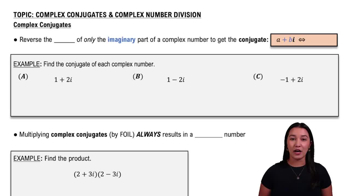Here are the essential concepts you must grasp in order to answer the question correctly.
Rationalizing the Denominator
Rationalizing the denominator involves rewriting a fraction so that the denominator is a rational number. This is often done by multiplying both the numerator and the denominator by a suitable expression that eliminates any irrational numbers, such as square roots. The goal is to simplify the expression while maintaining its value.
Recommended video:
Rationalizing Denominators
Square Roots
A square root of a number is a value that, when multiplied by itself, gives the original number. For example, the square root of 72 can be simplified to 6√2, since 72 = 36 × 2 and √36 = 6. Understanding how to simplify square roots is essential for rationalizing denominators effectively.
Recommended video:
Imaginary Roots with the Square Root Property
Multiplying by Conjugates
When dealing with expressions that contain square roots, multiplying by the conjugate can be a useful technique. The conjugate of a binomial expression is formed by changing the sign between two terms. This method is particularly helpful when the denominator is a binomial involving square roots, as it can eliminate the irrational part when multiplied.
Recommended video:
 Verified step by step guidance
Verified step by step guidance Verified Solution
Verified Solution



 2:9m
2:9m